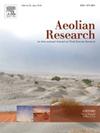Suspended dust particles in atmosphere have adverse impacts on environment, ecosystem as well as on human health. To avoid negative impacts of dust storm events, early warning system to predict it well in advance may be a suitable option. However, for this purpose, assessment on magnitude of dust load and its dynamics in atmosphere is a primary requirement. The present study aims to develop remote sensing based assessment of dust load in atmosphere specifically over the Indian Thar Desert region. The severe dust storm event occurred on 5th June 2017 over the Indian Thar Desert has been used in this study to develop integrated dust detection algorithm using split window technique, mid-infrared technique and different dust indices derived from MODIS and INSAT-3D data. Evaluation of the developed algorithm revealed that the area classified under dust load depends on threshold value of dust indices used in the algorithm, type of dust detection techniques followed and the specifications of remote sensing sensors used to retrieve the dust image. The integrated dust detection algorithm developed in this study has the capability to eliminate the problem in variations of predicted dust loadings in atmosphere. Validation of the developed algorithm to detect dust pixels showed good agreement with independent observations on aerosol optical depth (AOD), wind speed profile data and ground visibility data. The method adopted can be helpful to implement an operational system for detection and monitoring of dust storms over the Thar Desert region.


